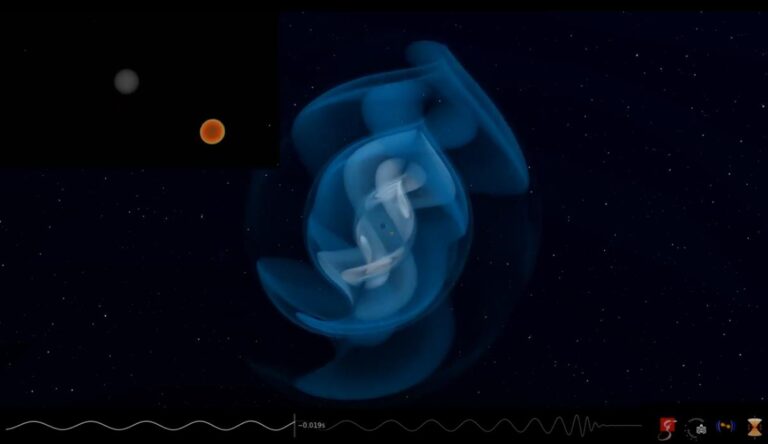电脑模拟: 二颗黑洞合并
请参阅说明。单击视频将下载可用的最高分辨率版本。

请参阅说明。单击视频将下载可用的最高分辨率版本。

2022年6月5日 Two Black Holes Dancing in 3C 75 Image Credit: X-Ray: NASA/CXC/D. Hudson, T. Reiprich et al. (AIfA); Radio: NRAO/VLA/ NRL Explanation: What’s happening at the center of active galaxy 3C 75? The two bright sources at the center of this composite x-ray (blue)/ radio (pink) image are co-orbiting supermassive black holes powering the giant radio source 3C 75. Surrounded by multimillion degree x-ray emitting gas, and blasting out jets of relativistic particles the supermassive black holes are separated by 25,000 light-years. At the cores of two merging galaxies in the Abell 400 galaxy cluster they are some 300 million light-years away. Astronomers conclude that these two supermassive black holes are bound together by gravity in a binary system in part because the jets’ consistent…

2021年12月07日 Ninety Gravitational Wave Spectrograms and Counting Image Credit: NSF, LIGO, VIRGO, KAGRA, Georgia Tech, Vanderbilt U.; Graphic: Sudarshan Ghonge & Karan Jani Explanation: Every time two massive black holes collide, a loud chirping sound is broadcast out into the universe in gravitational waves. Humanity has only had the technology to hear these unusual chirps for the past seven years, but since then we have heard about 90 — during the first three observing runs. Featured above are the spectrograms — plots of gravitational-wave frequency versus time — of these 90 as detected by the giant detectors of LIGO (in the USA), VIRGO (in Europe), and KAGRA (in Japan). The more energy received on Earth from a collision, the brighter it appears on the graphic….

2021年7月14日 GW200115: Simulation of a Black Hole Merging with a Neutron Star Video Credit: Simulation: S.V. Chaurasia (Stockholm U.), T. Dietrich (Potsdam U. & MPIGP); Visualization: T. Dietrich (Potsdam U. & MPIGP), N. Fischer, S. Ossokine, H. Pfeiffer (MPIGP) Explanation: What happens when a black hole destroys a neutron star? Analyses indicate that just such an event created gravitational wave event GW200115, detected in 2020 January by LIGO and Virgo observatories. To better understand the unusual event, the featured visualization was created from a computer simulation. The visualization video starts with the black hole (about 6 times the Sun’s mass) and neutron star (about 1.5 times the Sun’s mass) circling each other, together emitting an increasing amount of gravitational radiation. The picturesque pattern of gravitational…

2020年11月4日 Fifty Gravitational Wave Events Illustrated Image Credit: LIGO Virgo Collaborations, Frank Elavsky, Aaron Geller, Northwestern U. Explanation: Over fifty gravitational wave events have now been detected. These events mark the distant, violent collisions of two black holes, a black hole and a neutron star, or two neutron stars. Most of the 50 events were detected in 2019 by the LIGO gravitational wave detectors in the USA and the VIRGO detector in Europe. In the featured illustration summarizing the masses of the first 50 events, blue dots indicate higher-mass black holes while orange dots denote lower-mass neutron stars. Astrophysicists are currently uncertain, though, about the nature of events marked in white involving masses that appear to be in the middle — between two and five…